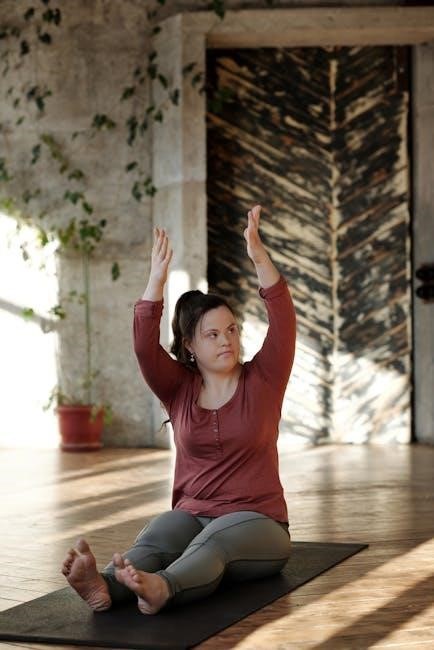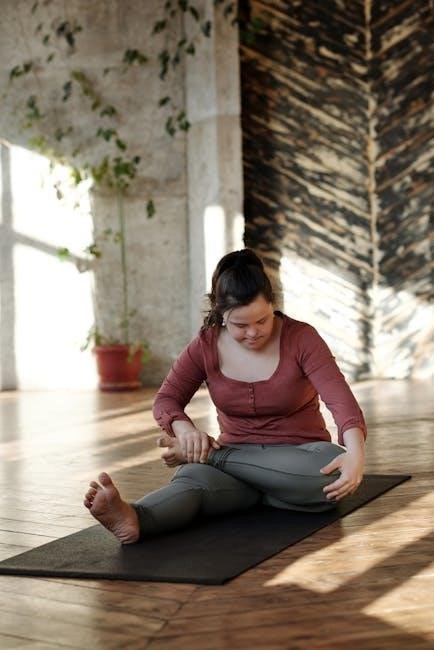IT Band Syndrome is a common overuse injury affecting athletes and active individuals, caused by repetitive friction on the iliotibial band. It often results from poor training techniques, weak hip muscles, or improper biomechanics. The condition leads to pain on the outside of the knee, especially during activities like running or cycling. Early diagnosis and conservative management, including targeted stretching and strengthening exercises, are key to recovery. This guide provides a comprehensive approach to understanding and addressing ITBS through effective exercise routines and prevention strategies.
1.1 Definition and Overview of IT Band Syndrome
IT Band Syndrome, or iliotibial band syndrome, is a common overuse injury characterized by inflammation of the iliotibial band, a ligament running down the outer thigh from the hip to the knee. It occurs when repetitive friction causes irritation, often due to activities like running, cycling, or hiking. The condition is prevalent among athletes and active individuals, particularly those with poor training techniques or weak hip muscles. Symptoms include sharp pain on the outside of the knee, especially during movement. While it can be debilitating, ITBS is treatable with conservative approaches, emphasizing stretching, strengthening, and proper biomechanics.
1.2 Prevalence Among Athletes and Active Individuals
IT Band Syndrome is prevalent among athletes and active individuals, particularly those engaged in running, cycling, and repetitive knee-bending activities. Studies indicate that approximately 10-15% of long-distance runners experience ITBS annually. Cyclists and triathletes are also at higher risk due to repetitive motion. Younger athletes and individuals with sudden increases in training intensity are more susceptible. Poor training techniques, such as overtraining or improper footwear, often contribute to its development. Addressing these factors through targeted exercises and prevention strategies is crucial for reducing incidence rates and maintaining athletic performance.

Causes and Risk Factors of IT Band Syndrome
IT Band Syndrome arises from repetitive stress, poor biomechanics, and muscle imbalances. Overuse, weak hip muscles, and improper training techniques are primary risk factors.
2.1 Overuse Injuries and Repetitive Stress
Overuse injuries and repetitive stress are primary contributors to IT Band Syndrome. Activities like running, cycling, or repetitive knee bending cause friction on the iliotibial band, leading to inflammation. Prolonged stress on the IT band, especially in sports requiring frequent leg movement, can result in chronic pain and discomfort. Proper rest and targeted exercises are essential to alleviate symptoms and prevent further damage. Addressing repetitive stress early helps avoid prolonged recovery periods, often taking 1-2 months with consistent management.
2.2 Poor Training Techniques and Biomechanics
Poor training techniques and biomechanics significantly contribute to IT Band Syndrome. Sudden increases in mileage, improper footwear, or cycling with an ill-fitted bike setup can strain the iliotibial band. Weak hip muscles and tightness in surrounding tissues often lead to altered running or cycling mechanics, increasing friction on the IT band. Addressing these issues through corrective exercises and proper form training is crucial. Strengthening the hip and glute muscles, along with improving running or cycling biomechanics, helps reduce repetitive stress and prevent ITBS recurrence. Incorporating these strategies into a structured exercise plan enhances recovery and long-term performance.
2.4 Weakness or Tightness in Surrounding Muscles
Weakness or tightness in the gluteus medius, tensor fascia latae (TFL), and other surrounding muscles often exacerbates IT Band Syndrome. When these muscles are imbalanced, the IT band is subjected to increased friction and strain, especially during repetitive movements like running or cycling. Strengthening exercises targeting the glutes and hips can help restore proper muscle function and reduce IT band tension. Additionally, stretching the TFL and improving flexibility in the hip region are critical for alleviating tightness. Addressing these muscle imbalances through targeted exercises is essential for both recovery and prevention of ITBS, ensuring better biomechanical alignment and reduced risk of recurrence.

Symptoms and Diagnosis of IT Band Syndrome
IT Band Syndrome typically causes sharp pain on the outside of the knee, worsening with activities like running or cycling. Diagnosis involves physical exams, palpation, and sometimes imaging to confirm the condition and rule out other causes.
3.1 Common Pain Areas and Sensations
IT Band Syndrome typically causes pain on the outside of the knee, often described as sharp or stabbing. Pain may radiate along the iliotibial band, from the hip to the knee. Tenderness or swelling near the lateral knee is common, and discomfort worsens with activities like running, cycling, or descending stairs. Some individuals experience a snapping or popping sensation along the IT band. Pain usually intensifies during repetitive movements and may subside with rest. In severe cases, swelling or warmth around the knee may occur, indicating inflammation. Accurate diagnosis is crucial to differentiate ITBS from other knee conditions.
3.2 Diagnostic Tests and Medical Evaluation
Diagnosing IT Band Syndrome involves a combination of physical exams and imaging. Physicians often perform palpation along the iliotibial band to identify tenderness or swelling. The Noble’s test is commonly used, where pressure is applied to the IT band while the patient flexes and extends the knee. Imaging such as X-rays or MRIs may be used to rule out other knee conditions like meniscal tears or ligament damage. A clinical evaluation focuses on assessing pain during activities like running or stair navigation. Proper diagnosis is essential to differentiate ITBS from other causes of lateral knee pain and ensure appropriate treatment.
Treatment Options for IT Band Syndrome
Treatment focuses on reducing pain and inflammation through conservative methods like rest, ice, and physical therapy. Stretching and strengthening exercises are often prescribed to restore function.
4.1 Conservative Management Strategies
Conservative management is often the first line of treatment for IT Band Syndrome, focusing on reducing pain and inflammation. This typically includes rest, ice, and anti-inflammatory medications to alleviate symptoms. Gentle stretching and strengthening exercises are introduced to improve flexibility and strengthen surrounding muscles. Physical therapy plays a crucial role in guiding these exercises and ensuring proper technique. The goal of conservative strategies is to restore normal function and reduce friction on the iliotibial band. These methods are effective for most patients and can prevent the need for more invasive treatments.
4.2 Role of Physical Therapy in Recovery
Physical therapy is a cornerstone in the recovery from IT Band Syndrome, offering personalized exercise programs tailored to address specific weaknesses and imbalances. Therapists use manual techniques, such as massage and joint mobilization, to reduce tension and improve mobility. They also guide patients through structured stretching and strengthening exercises to enhance hip and gluteal function. Education on proper biomechanics and training techniques is emphasized to prevent recurrence. Regular sessions with a physical therapist can accelerate healing, restore normal movement patterns, and help patients safely return to their athletic or daily activities with reduced risk of future injury.

Exercise-Based Approach to IT Band Syndrome
An exercise-based approach focuses on addressing muscle imbalances, improving flexibility, and enhancing strength to alleviate IT Band Syndrome symptoms effectively through targeted movements and routines.
5.1 Importance of Stretching and Strengthening
Stretching and strengthening exercises are crucial for managing IT Band Syndrome. Stretching improves flexibility, reducing tightness in the iliotibial band and surrounding muscles, while strengthening builds resilience in the hips and glutes. These exercises address muscle imbalances and poor biomechanics, common causes of ITBS. Strengthening the gluteus medius and other stabilizing muscles helps correct movement patterns, preventing further strain. Combining stretching with targeted strength training promotes recovery and reduces the risk of recurrence. This dual approach is essential for restoring function and enabling a return to normal activity levels effectively.
5.2 Focus on Hip and Gluteus Medius Activation
Activating the hip and gluteus medius muscles is vital for addressing IT Band Syndrome. Weakness in these areas often contributes to ITBS, as it disrupts proper hip and knee alignment. Strengthening the gluteus medius improves hip stability, reducing strain on the iliotibial band. Exercises like clamshells and side-lying leg lifts target these muscles, enhancing functional movement patterns. Proper activation also corrects biomechanical issues, such as excessive hip drop during running, which can exacerbate ITBS. Focusing on these muscles not only aids recovery but also prevents future episodes by ensuring efficient energy transfer and movement mechanics during physical activities like cycling or running.

Stretching Exercises for IT Band Syndrome
Stretching exercises are essential for relieving IT Band Syndrome symptoms. They target tightness and improve flexibility, reducing friction on the iliotibial band. Regular stretching helps alleviate pain and prevent future episodes.
6.1 Standing Iliotibial Band Stretch
The standing iliotibial band stretch is an effective exercise to alleviate tightness and pain associated with IT Band Syndrome. To perform this stretch, stand sideways near a wall for balance. Cross your injured leg behind your uninjured leg, keeping your feet apart. Lean toward the wall, bending your front knee slightly, until you feel a stretch on the outside of your thigh. Hold this position for 20-30 seconds and repeat 2-3 times on each side. This stretch targets the iliotibial band, improving flexibility and reducing friction near the knee. Regular practice can help prevent recurrence of symptoms.
6.2 Side-Leaning IT Band Stretch
The side-leaning IT band stretch is a simple yet effective exercise to relieve tension and improve flexibility. Stand sideways near a wall for support, with your injured leg farthest from the wall. Place the hand nearest the wall on the wall for balance. Slowly lean toward the wall, bending your front knee slightly, until you feel a stretch on the outside of your thigh. Maintain this position for 20-30 seconds and repeat 2-3 times on each side. This stretch helps reduce tightness in the iliotibial band and can be incorporated into daily routines to prevent IT Band Syndrome symptoms.
6.3 Seated IT Band Stretch
The seated IT band stretch is an excellent exercise to target the iliotibial band while maintaining proper posture. Sit on the floor with your legs extended straight. Cross the affected leg over the other, placing the foot flat on the ground. Slowly bend forward from your hips, reaching toward your toes, until you feel a stretch on the outside of your thigh. Keep your back straight and hold the stretch for 20-30 seconds. Repeat 2-3 times on each side. This stretch helps reduce tightness and improves mobility, making it a valuable addition to your IT band syndrome exercise routine.

Strengthening Exercises for IT Band Syndrome
Strengthening exercises target the glutes, hips, and surrounding muscles to improve stability and reduce IT band stress. Clamshell, side-lying leg lifts, and glute bridges are effective options to build strength progressively.
7.1 Clamshell Exercise
The clamshell exercise is a highly effective strengthening exercise for IT band syndrome, targeting the gluteus medius and hip abductors. To perform it, lie on your side with knees bent and feet touching. Slowly lift the top knee away from the bottom knee while keeping the feet together, holding for a few seconds before lowering. This movement strengthens the hip muscles, improving stability and reducing IT band tension. Adding a resistance band around the thighs can increase the challenge. Incorporate 2-3 sets of 15-20 repetitions into your routine to enhance hip function and alleviate IT band symptoms effectively.
7.2 Side-Lying Leg Lifts
Side-lying leg lifts are an excellent exercise for strengthening the hip abductors and gluteus medius, which are crucial for addressing IT band syndrome. To perform this exercise, lie on your side with your legs straight and feet touching. Slowly lift the top leg away from the bottom leg, keeping it straight, then lower it back down. Avoid rotating your hips or using momentum. Start with 2-3 sets of 15-20 repetitions and gradually increase as strength improves. This exercise helps improve hip stability, reduces IT band tension, and enhances proper knee tracking, making it an essential part of ITBS recovery routines.
7.3 Glute Bridges
Glute bridges are an effective exercise for strengthening the gluteus maximus and hamstrings, which play a key role in hip stability and IT band syndrome recovery. To perform a glute bridge, lie on your back with knees bent and feet flat on the floor. Engage your core, squeeze your glutes, and lift your hips toward the ceiling until your knees, hips, and shoulders form a straight line. Hold for a few seconds, then slowly lower back down. Aim for 3 sets of 12-15 repetitions. This exercise enhances posterior chain strength, improves hip mobility, and reduces IT band tension, aiding in overall lower limb functionality.
Functional and Mobility Exercises
Functional and mobility exercises, like step-ups and foam rolling, enhance hip stability and IT band flexibility. These movements improve joint mobility and strengthen surrounding muscles, aiding recovery and preventing future injuries.
8.1 Step-Ups for Hip Stability
Step-ups are an excellent exercise for improving hip stability, a key factor in managing IT band syndrome. To perform, stand in front of a sturdy step or platform, 6-8 inches high. Step up with one leg, keeping the other foot behind. Maintain proper posture, engage your core, and avoid leaning forward. Slowly lower yourself back down to the starting position. This exercise strengthens the gluteus medius and hip abductors, enhancing pelvic alignment and reducing IT band stress. Variations, such as lateral step-ups, can further target hip muscles. Consistency in this exercise promotes long-term hip stability and injury prevention.
8.2 Foam Rolling for IT Band Mobility
Foam rolling is a highly effective technique for improving IT band mobility and reducing tightness. Using a large foam roller, roll along the outer thigh from the hip down to the knee. Apply moderate pressure, focusing on areas of tension or discomfort. Move slowly and deliberately, pausing on tender spots to release muscle spasms. Regular foam rolling enhances blood flow, breaks down adhesions, and restores flexibility to the IT band. It is a simple yet powerful tool for maintaining mobility and preventing IT band syndrome, especially when incorporated into a daily or pre-workout routine.

Preventative Exercises and Routines
Regular routines incorporating stretching, strengthening, and foam rolling can help prevent ITBS by addressing muscle imbalances and enhancing mobility, promoting long-term joint health and stability.
9.1 Daily Stretching Routine
A consistent daily stretching routine is essential for preventing IT Band Syndrome. Focus on stretching the iliotibial band, gluteus medius, and hip flexors. Begin with the standing iliotibial band stretch, holding for 30 seconds on each side. Incorporate side-leaning stretches to target the outer thigh and hip. Seated stretches can also be effective for deeper tissue release. Aim for 10-15 minutes daily, ensuring proper form to avoid overstretching. Combine these with foam rolling to improve mobility and reduce muscle tension. Consistency is key to maintaining flexibility and preventing irritation of the IT band, especially for active individuals or athletes. Regular stretching supports long-term joint health and stability.
9.2 Weekly Strengthening Program
A weekly strengthening program is crucial for addressing IT Band Syndrome by targeting the gluteus medius, hip abductors, and core muscles. Perform exercises like clamshell, side-lying leg lifts, and glute bridges 3-4 times weekly. Include step-ups and mini-band walks to enhance hip stability. Focus on controlled movements and proper form to avoid exacerbating symptoms. Gradually increase resistance or repetitions as strength improves. Combining these exercises with daily stretching and foam rolling creates a comprehensive routine. Consistency in this program helps rebuild muscle balance, reduce IT band irritation, and prevent future injuries. A well-structured strengthening plan is essential for long-term recovery and athletic performance.

Creating a PDF Guide for IT Band Exercises
Creating a PDF guide for IT Band exercises provides a structured resource for managing symptoms and improving recovery. Include clear instructions, visuals, and safety tips for effective exercises.
10.1 Structuring the PDF for Clarity
Structuring a PDF guide for IT Band exercises involves organizing content logically to enhance readability and usability. Begin with an introduction explaining IT Band Syndrome and its causes. Include sections dedicated to symptoms, diagnosis, and the importance of exercise-based recovery. Separate exercises into categories, such as stretching, strengthening, and mobility routines, using clear headings and bullet points. Incorporate high-quality images or diagrams to illustrate proper form and techniques. Add a table of contents and index for easy navigation. Use consistent formatting and fonts to maintain a professional appearance. This clear structure ensures users can follow the guide effortlessly, making it a valuable resource for recovery and prevention.
10.2 Including Visual Aids and Instructions
Including high-quality visual aids and detailed instructions in the PDF guide enhances user understanding and ensures proper execution of exercises. Use images, diagrams, or videos to demonstrate correct postures and movements for IT Band stretches and strengthening routines. Step-by-step instructions should accompany each visual, specifying breathing techniques, duration, and frequency. Incorporate bullet points or checklists to break down complex movements, making the guide user-friendly. Clear visuals help prevent misinterpretation and promote safety. Additionally, include a section for users to note their progress or track workouts, fostering accountability and personalized recovery.

Case Studies and Success Stories
Real-life examples highlight athletes and active individuals who successfully recovered from IT Band Syndrome using targeted exercise routines. Their stories validate the effectiveness of the guide’s approach.
11.1 Athletes Who Recovered Using Exercise Plans
Several athletes have successfully recovered from IT Band Syndrome by adhering to structured exercise plans. These plans included targeted stretching, strengthening, and functional exercises. For instance, a long-distance runner incorporated standing IT band stretches, side-leaning stretches, and seated stretches into their daily routine. Strengthening exercises like clamshell exercises, side-lying leg lifts, and glute bridges were also essential. By combining these with foam rolling and step-ups for hip stability, they achieved significant pain reduction and improved mobility. Consistency and gradual progression were key factors in their full recovery, enabling them to return to competitive performance without recurrence.
11.2 Real-Life Examples of Exercise Routines
Many individuals have shared successful exercise routines for IT Band Syndrome recovery. One cyclist incorporated standing IT band stretches, side-leaning stretches, and seated stretches daily. Another runner focused on strengthening exercises like clamshell exercises and side-lying leg lifts, while also using foam rolling for mobility. A triathlete added step-ups and glute bridges to their routine, emphasizing hip stability. These real-life examples highlight the importance of consistency and gradual progression. Combining stretching, strengthening, and functional exercises tailored to individual needs has proven effective in alleviating symptoms and restoring activity levels. These routines serve as practical models for others seeking to address ITBS.
Expert Recommendations
Experts emphasize the importance of tailored exercise plans for ITBS, focusing on hip stability and gluteus medius activation. They recommend combining stretching and strengthening exercises with proper form. Consulting a physical therapist for personalized routines is also advised to address specific weaknesses and improve mobility.
12.1 Guidelines from Sports Medicine Professionals
Sports medicine professionals recommend a multi-faceted approach to managing IT Band Syndrome, emphasizing hip stability and gluteus medius activation. They suggest combining targeted stretching with strengthening exercises to address muscle imbalances. Proper form and gradual progression are crucial to avoid overloading the IT band. Rest and activity modification are also advised to reduce inflammation. Professionals further recommend incorporating core strengthening and mobility exercises to improve overall lower limb mechanics. Adherence to these guidelines can promote effective recovery and reduce the likelihood of recurrence, ensuring a safe return to athletic activities.
12.2 Tips for Customizing Exercise Plans
Customizing exercise plans for IT Band Syndrome requires assessing individual needs and activity levels. Start with gentle stretches like the side-leaning IT band stretch and progress to strengthening exercises such as clamshell exercises or side-lying leg lifts. Incorporate daily stretching routines and weekly strengthening programs tailored to address specific weaknesses. Focus on improving hip stability and gluteus medius activation to reduce strain on the IT band. Foam rolling and step-ups can enhance mobility and strength. Monitor progress and adjust routines as symptoms improve. Always consult a healthcare professional to ensure exercises align with recovery goals and prevent overloading the IT band.
IT Band Syndrome can be effectively managed with targeted exercises, proper prevention strategies, and a focus on hip and glute strength. Recovery requires consistency and patience.
13.1 Summary of Key Points
IT Band Syndrome is a common overuse injury causing lateral knee pain, often due to repetitive friction and weak hip muscles. Athletes and active individuals are most affected. Early diagnosis and conservative management, including stretching, strengthening, and foam rolling, are essential for recovery. Targeted exercises focus on hip stability and glute activation to address root causes. Prevention strategies, such as proper training techniques and daily routines, play a crucial role in avoiding recurrence. Consistency and patience are key, as recovery typically takes several weeks. This guide provides a comprehensive approach to managing ITBS through effective exercises and proactive prevention.
13.2 Encouragement for Proactive Recovery
Taking charge of your recovery from IT Band Syndrome is the first step toward healing and preventing future injuries. Consistency in performing targeted exercises, such as stretching, strengthening, and foam rolling, is crucial for restoring hip stability and reducing pain. Incorporate these routines into your daily schedule to promote long-term recovery. Stay proactive by listening to your body and adjusting your activities to avoid overuse. With patience and dedication, you can overcome ITBS and return to your active lifestyle pain-free. Remember, proactive recovery not only addresses symptoms but also builds resilience for the future.

References and Further Reading
Academic studies and expert guidelines provide detailed insights into IT Band Syndrome management. Sources like the American Association of Hip and Knee Surgeons (AAHKS) and UCSF offer comprehensive exercise routines and recovery strategies. These resources are essential for understanding the condition and implementing effective treatment plans.
14.1 Academic Studies on IT Band Syndrome
Several academic studies have investigated IT Band Syndrome, focusing on its causes, symptoms, and treatment options. Research by authors like A.F. Murtazina and VI Averin highlights the role of repetitive stress and biomechanical factors. These studies emphasize the importance of exercise-based rehabilitation, particularly targeting the gluteus medius and hip muscles. Institutions such as the American Association of Hip and Knee Surgeons (AAHKS) and UCSF have published detailed exercise protocols for ITBS management. These studies provide evidence-based support for the exercise plans outlined in this guide, ensuring a comprehensive approach to recovery and prevention.
14.2 Reliable Sources for Exercise Plans
Trusted sources like the American Association of Hip and Knee Surgeons (AAHKS) and universities such as UCSF provide evidence-based exercise plans for ITBS. Authors like A.F. Murtazina and VI Averin have published studies detailing effective routines. Websites like sportsrehab.ucsf.edu and Dartmouth-Hitchcock offer downloadable PDF guides with structured exercises. These sources emphasize stretching the IT band, strengthening the glutes, and improving hip mobility. They also include visual aids and step-by-step instructions, making them invaluable for creating personalized recovery programs. These resources are widely recognized for their reliability and effectiveness in addressing ITBS through exercise-based approaches.
